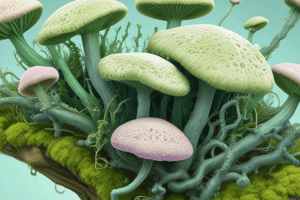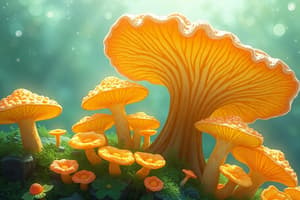Podcast
Questions and Answers
What is the primary mechanism by which algal fungi obtain their carbon requirements?
What is the primary mechanism by which algal fungi obtain their carbon requirements?
- Symbiotic relationships with photosynthetic organisms (correct)
- Direct absorption of carbon dioxide from the atmosphere
- Decomposition of organic matter
- Parasitic relationships with non-photosynthetic organisms
Which of the following is an example of a mycorrhizal association involving algal fungi?
Which of the following is an example of a mycorrhizal association involving algal fungi?
- Algal fungi living within the cells of a green alga
- Algal fungi growing inside the tissues of a plant without causing harm
- Algal fungi forming a mutualistic relationship with potato plant roots (correct)
- Algal fungi interfering with the photosynthetic process of a plant host
In which type of association do algal fungi live within the tissues of their hosts without causing any apparent harm?
In which type of association do algal fungi live within the tissues of their hosts without causing any apparent harm?
- Decomposition associations
- Endophytic associations (correct)
- Mycorrhizal associations
- Photosynthetic-independent parasites
What is the potential consequence of the association between algal fungi and their photosynthetic hosts in the case of photosynthetic-independent parasites?
What is the potential consequence of the association between algal fungi and their photosynthetic hosts in the case of photosynthetic-independent parasites?
Which of the following statements accurately describes the relationship between algal fungi and their photosynthetic partners?
Which of the following statements accurately describes the relationship between algal fungi and their photosynthetic partners?
Which of the following plants is NOT mentioned as an example of a host involved in a mycorrhizal association with algal fungi?
Which of the following plants is NOT mentioned as an example of a host involved in a mycorrhizal association with algal fungi?
Which of the following statements accurately describes the relationship between algal fungi and their host organisms?
Which of the following statements accurately describes the relationship between algal fungi and their host organisms?
What potential benefit of algal fungi is mentioned in the text?
What potential benefit of algal fungi is mentioned in the text?
Which of the following statements accurately describes a potential risk associated with algal fungi?
Which of the following statements accurately describes a potential risk associated with algal fungi?
How can algal fungi impact crops like potatoes?
How can algal fungi impact crops like potatoes?
What is the primary focus of studying algal fungi, according to the text?
What is the primary focus of studying algal fungi, according to the text?
Which of the following statements best summarizes the overall role of algal fungi in ecosystems?
Which of the following statements best summarizes the overall role of algal fungi in ecosystems?
Flashcards are hidden until you start studying
Study Notes
Algal Fungi
Algal fungi, also known as mycoheterotrophic fungi, are unique organisms that exhibit symbiotic relationships with photosynthetic partners. These fungi obtain their carbon requirements from other organisms that produce organic compounds through photosynthesis. Unlike traditional heterotrophic fungi that rely solely on decomposition, these fungi have evolved a complex mechanism of obtaining nutrients that allows them to live within certain strains of plants, particularly green algae.
Characteristics of Algal Fungi
Algal fungi can be classified into three main types based on their association with photosynthetic partners:
-
Mycorrhizal associations: These fungi form mutualistic relationships with plant roots, providing nutrients while receiving carbohydrates produced by the host plant through photosynthesis. Examples of common plants involved in this type of relationship include Solanum tuberosum (potato) and Raphanus sativus (radish).
-
Photosynthetic-independent parasites: Some algal fungi interfere with the photosynthetic process of their hosts without directly consuming their photosynthetic products. They often grow inside the cells of their hosts, which may lead to disorganization of chloroplasts and impaired photosynthetic function.
-
Endophytic associations: In this type of relationship, the fungi live within the tissues of their hosts without causing any apparent harm. While they do not act as parasites or pathogens, they can still influence host development and physiology.
Benefits and Risks of Algal Fungi
While algal fungi play a crucial role in maintaining the ecological balance, their presence comes with both benefits and risks. On one hand, they contribute to the growth and survival of their host organisms. For example, the association between specific endemic strains of algal fungi and their host plants has been observed in Hawaiian plants, suggesting potential benefits for these species.
On the other hand, the presence of algal fungi can sometimes pose a threat to native ecosystems. Algal fungi associated with invasive alien species can enhance their invasiveness and competitiveness, leading to changes in community composition and ecological functioning. Moreover, algal fungi can negatively impact crops like potato, reducing yield and quality due to abnormalities in the tubers.
In conclusion, algal fungi represent a fascinating aspect of the evolution and adaptability of diverse life forms. By understanding their mechanisms of interaction with host organisms and exploring their roles in ecological systems, we gain valuable insights into the complex web of biological relationships that shape our world.
Studying That Suits You
Use AI to generate personalized quizzes and flashcards to suit your learning preferences.




